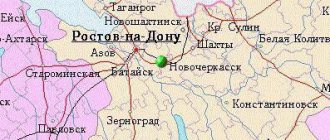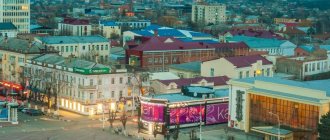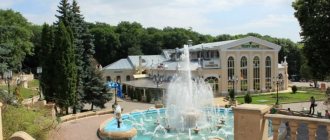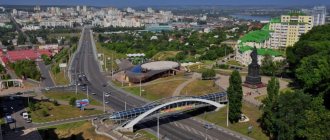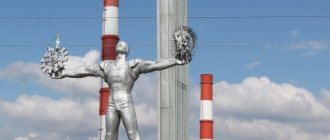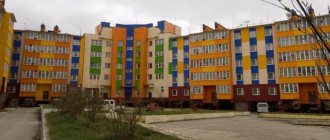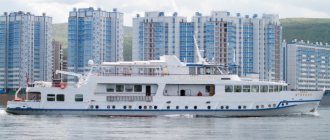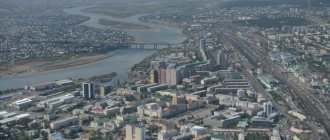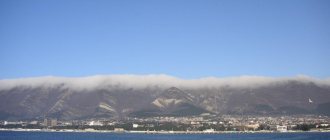Founded: 1593
City Day is celebrated
on August 5th
.
Belgorod station
Belgorod
- a Russian city, the center of the Belgorod region, located on the Seversky Donets River.
It is believed that the Slavic city of Belgorod was founded in the 10th century
.
However, it was later destroyed and the lands remained empty for a long time. Tsar Fyodor Ioannovich revives the city again, founding a border fortress in 1593
. In 1622, during an attack by Polish-Lithuanian troops, the fortress was burned. After this, Belgorod was built on the left, eastern bank of the Seversky Donets - now the Old Town is located there.
The Belgorod fortress was built in 1650 on the right bank of the Seversky Donets at the confluence of the Vezelitsa River. Since 1658, Belgorod was the main city of the Belgorod Line - a defensive line that protected the Muscovite kingdom.
In 1712, by decree of Peter I, the banner of the Belgorod Infantry Regiment, which especially distinguished itself in the Battle of Poltava, was introduced. The banner depicts an eagle, the symbol of Russia, soaring above a running lion, the symbol of Sweden. It is this symbolism that is the basis of today’s coat of arms and flag of the city.
During the Great Patriotic War, Belgorod was twice occupied by German troops and liberated from the Nazi invaders after the battles on the Kursk Bulge.
House of the merchant Selivanov In 1954, the Belgorod region was formed. In 1980, the city was awarded the Order of the Patriotic War, 1st degree, for the courage and fortitude shown during the Great Patriotic War and for the successes achieved in economic and cultural construction.
Now the city is actively developing and has a positive population growth. Belgorod has repeatedly taken the honorable first place in terms of cleanliness and livability among Russian cities. In 2007, by decree of the President of the Russian Federation, Belgorod was awarded the title “City of Military Glory”.
This oak tree dates back to the fifth century
It is interesting to visit
in Belgorod the diorama of the Battle of Kursk, the military-historical museum-reserve “Prokhorovskoe Field”, the Transfiguration Cathedral, the Assumption-Nicholas Cathedral, the Smolensk Cathedral, the house of the merchant Selivanov. Around the city there are many ancient estates with their unique atmosphere.
A unique oak grows in the Belgorod region; its crown occupies 25 acres. The tree is over 400 years old. This tree is one of three that are protected by the state as a natural monument in Russia.
The city has a population of about 392 thousand people (2018).
Day of the city
celebrated on August 5 in memory of the liberation of the city from the Nazi invaders in 1943. It was this day that became the day of the first fireworks display in the Great Patriotic War. Fireworks were fired in two liberated cities - Belgorod and Orel.
BELGOROD
BELGOROD, a city in the Russian Federation, the administrative center of the Belgorod region. Forms a city district. Population 392.4 thousand people. (2019; 356.4 thousand people in 2010, 337.0 thousand people in 2002, 300.4 thousand people in 1989, 72.3 thousand people in 1959), within the urban agglomeration (including villages of Severny, Razumnoye, Dubovoe, Streletskoye, Maysky, Tavrovo, etc.) approx. 0.5 million people Located on the southern edge of the Central Russian Upland, on the river. Seversky Donets, 42 km north of the border with Ukraine. A railway junction to Moscow, Kharkov, Kupyansk, Sumy (all three are Ukraine). Motorway Moscow – Kharkov (Ukraine) – Simferopol; highways Belgorod - Stary Oskol, Belgorod - Valuyki, Belgorod - Grayvoron. The Shebelinka (Ukraine) – Moscow gas pipeline passes through the city. International airport (1954; 455 thousand passengers, 2018).
Story
Belgorod. View of the city. Photo by V. S. Ivanov
The decision to build Belgorod was made by the Boyar Duma in 1593, at which time a settlement probably arose on the site of the future city. The Belgorod fortress was built by decree of Tsar Fyodor Ivanovich in the fall of 1596. The total area of Belgorod was 33 hectares. During the Time of Troubles, the garrison of the fortress went over to the side of False Dmitry I, and after his death they supported False Dmitry II. In 1612, the fortress was captured and burned by a detachment of Poltava Cherkasy (Cossacks) under the command of Prince S.I. Lyko, who came from the Polish-Lithuanian Commonwealth. In 1613 it was rebuilt again by the remaining residents under the leadership of governor N.P. Likharev, but on the opposite, left, bank of the river. Seversky Donets (the area of the fortress is 9 hectares, the central part is 150x130 m with 8 towers, structurally it was a standing fort with military superstructures - oblamas, from the north it was adjoined by a large fort with 15 towers, the perimeter of the walls was 1.12 km). In 1650 the fortress was moved to the right bank of the river. Seversky Donets to Karpovsky Val of the Belgorod Line (now the center of Belgorod). After the creation of the Belgorod discharge and the formation of the Belgorod discharge regiment, the command of the armed forces of the region, economic, administrative and judicial management of the region were concentrated in the city. K con. 17th century Belgorod (Detinets and the adjacent Zemlyanoy town) occupied the territory of St. 90 hectares. In 1727–79 the center of the Belgorod province. In 1766, most of the wooden buildings of Zemlyanoy Town burned down. According to the regular development plan for Belgorod, developed by architect. A.V. Kvasov and approved in 1768 by Empress Catherine II, the position of the Detinets fortress remained unchanged, but the layout of other parts of the city was fundamentally altered, which has been preserved to this day. In 1779–1928 Belgorod was a district town of the Kursk governorate (from 1796 – Kursk province). In 1785 it was excluded from the list of fortresses. In 1869, a section of the Kursk-Kharkov railway was laid through Belgorod. d.
On October 26, 2017, Soviet power was established in the city. After the signing of the Treaty of Brest-Litovsk in 1918, in April of the same year it was occupied by German troops and until the end of 1918 it was part of the Ukrainian state of Hetman P. P. Skoropadsky. At the end of December 1918 - beginning of January 1919, the Provisional Workers' and Peasants' Government of Ukraine was located in Belgorod. In the summer of 1919 it was occupied by units of the Armed Forces of the South of Russia, in December 1919 it was liberated by the troops of the Workers 'and Peasants' Red Army. District (since 1930 district) center of the Central Chernozem Region (1928–34), Kursk Region (1934–54) of the RSFSR. Since 1930 it has been a city of regional significance. On October 24, 1941, during the Great Patriotic War, Belgorod was occupied by German troops, and on February 9, 1943 it was occupied by Soviet troops. 18.3.1943 occupied again. Finally liberated during the Battle of Kursk in 1943. In honor of the liberation of Belgorod and Orel, the first artillery salute during the Great Patriotic War was given in Moscow on August 5, 1943. Since 1954 the center of the Belgorod region. City of Military Glory (2007)
Architecture
In the city center, the street network of the regular plan of 1768 has been preserved (architect A.V. Kvasov). Among the architectural monuments: cathedrals - Smolensky (1727–63, restored in the 1980s - 1996), Spaso-Preobrazhensky (1813, architect E. A. Vasiliev); part of the Assumption-Nicholas Cathedral (1709); Church of the Intercession (1791; restored since 1991) of the Marfo-Mariinsky Monastery; St. Michael's (1844) and Holy Cross (1863) churches; church (early 19th century; restored in 2005 for the Center for Spiritual Education); buildings of a men's (1879) gymnasium and a women's diocesan school (1908, architect R.I. Mühlhaupt), mansions of the late 18th–19th centuries, hotels of the 19th century, the Orion cinema (1910). Belgorod suffered severe destruction during the Great Patriotic War and was restored from the late 1940s. Since the 1990s major construction and improvement programs are being implemented (university building complex, 2001; stadium of the Belgorod State Technological University named after V. G. Shukhov, 2004, etc.). Memorial ensembles of the Great Patriotic War. Monuments, including General I. R. Apanasenko (1949, sculptor N. V. Tomsky, architect L. G. Golubovsky), M. S. Shchepkin (1988; sculptors V. M. Klykov, A. A Shishkov), Prince Vladimir Svyatoslavich (1998, sculptor Klykov), etc.
Centers of science and culture
An important center of science, culture and education in the Central Black Earth region. There are scientific research institutes: "Belgorodgrazhdanproekt" (1954; design of construction projects), All-Russian Institute for Drainage of Mineral Deposits, Protection of Engineering Structures from Watering, Special Mining, Geomechanics, Geophysics, Hydraulic Engineering, Geology and Surveying (VIOGEM; 1959), “Tsentrogiproruda” (1960; design of mining enterprises in Central Russia), Belgorod Agriculture RAAS (1975). Universities: State National Research University (1876; it includes a museum), State Technological University named after. V. G. Shukhov (1954), cooperation, economics and law (1978), State Agrarian University named after. V. Ya. Gorina (1978; in the village of Maisky); institutes: arts and culture (1960), legal Ministry of Internal Affairs of the Russian Federation named after. I. D. Putilina (1985), engineering and economics (1997); branches of other universities. Belgorod Orthodox Theological Seminary (1787). Libraries: State Universal Scientific (1897), Central City. Nikolai Ostrovsky (1975), Pushkin Library-Museum (1992). Museums: historical and local history (1924), art (1983), Museum-diorama “Battle of Kursk. Belgorod direction" (1987), folk culture, literary (both - 1999), etc.
Theatres: State Academic Drama named after. M. S. Shchepkina (1936), dolls (1961; it includes a museum), children's musical (1991), state songs (2001), fashion “Panther” (2002), “Two Monkeys” (clownery; 2009), etc. State Philharmonic (1966) with three concert halls (Bolshoi for 700 seats, Chamber Music for 300 seats, Organ for 180 seats); with her - a symphony orchestra (1993); vocal and choreographic ensemble "Belogorye" (1971), orchestra of Russian folk instruments, concert orchestra of wind instruments (both - 1990), chamber choir (1992). Center for Folk Art (1955), includes children's: orchestra of wind instruments, vocal and choreographic ensemble "Carousel", folk theater "Lapotochki", music and theater studio "Lestvitsa", as well as folk ensemble "Bylina", studios of Russian folk dance and ballroom dance "Prestige", folk ensemble "Peresek", orchestra of wind instruments, ensemble of Russian folk instruments "Zhaleika", etc. Annual festivals are held in Belgorod: international puppet theater "Belgorod Fun" (since 1995), all-Russian theater "Actors of Russia - Mikhail Shchepkin" (since 1988), street art "White Mask" (since 2014). Zoo (1988).
Sport
Volleyball club "Belogorye" (founded in 1976; modern name in 1992–93, 1995–97 and since 2011) – 8-time champion (from 1997 to 2013) and 8-time winner of the Russian Cup (from 1995 to 2013) , 3-time winner of the Champions League (2003–2004 and 2014), winner of the CEV Cup (2009 and 2018), Challenge Cup (formerly the Cup Winners' Cup; 2019), winner of the Club World Cup (2014). The home arena is the Cosmos Sports Palace (1982; 5068 seats). Football club "Salut Belgorod" (1960; until 2014, when it was disbanded, played under the name "Salut"; revived in 2018) holds its matches at the stadium of the same name (1959; 11,456 seats). In 2007, the educational and sports complex of the National Research University “BelSU” by Svetlana Khorkina was opened.
Farm
The basis of the city economy is the service sector, incl. administrative, transport and logistics services and trade. Belgorod has St. 47% of retail trade turnover in the Belgorod region. (2018). Leading industries: mechanical engineering and metalworking, production of building materials, food processing; The light, chemical and woodworking industries are also represented. The products of many enterprises are supplied to foreign countries. Among the enterprises of mechanical engineering and metalworking - (multi-profile, one of the main Russian manufacturers of power equipment - steam boilers, bellows expansion joints, steel building structures, including for bridges, power line supports and chimneys, parts and assembly units of pipelines), Belgorod plant mining engineering (drilling tools, special vehicles for quarry work, spare parts for engines and units of quarry equipment), "Admiral" (gate valves, shutters, pipeline valves), "Rhythm" (agricultural machinery, equipment for livestock complexes), "Belagromash-Service named after. V. M. Ryazanov" (tillage equipment), "Veles" (equipment for livestock breeding complexes), "Kolos Belogorya" (equipment for grain processing enterprises), Belgorod Electrotechnical Plant (electric motors and generators), "Tenko" (production of electric boilers, electric radiators, tubular electric heaters, etc.), "TransEnergo" (electrical equipment), "Energotekhmontazh" (both have a wide range of electrical equipment), "Mica Factory" (electric soldering irons and electric heaters on a mica-plastic basis), scientific and production enterprise "Electropromplast" ( electrical installation products), "Sokol-ATS" (electronic equipment, electronic control systems and components for them for the needs of aircraft construction, shipbuilding, telecommunications) and MicroDAT Plant (programmable logic controllers and means for automating technological processes of industrial enterprises), Belgorod Abrasive Plant (the largest manufacturer flexible grinding tools - sandpaper and products made from it), a tool plant (electric and gas tools, pneumatic tools and pneumatic equipment, hand tools), Belgorod Steel Structures Plant, "Plant-Novator" (both metal structures) and Belgorod Metal Products Plant (tin containers ). The construction materials industry is represented by the following enterprises: “Belgorod Cement” (in the structure; production of high-quality cement), “Belgorodasbestotsement” (asbestos-cement sheets, pipes and other products), “ZhBK-1 Corporation” and (both reinforced concrete structures), “ARD- Teplosten" (energy-saving three-layer blocks "Teplosten"), "Building materials" (hydrate, construction and lump lime, lime flour, natural and technical chalk, sand-lime brick, etc.); Belgorod plant of thermal insulation materials “IZOVOL”; food-flavoring industry - plants: grain "Zolotoy Kolos" (as part of the agro-industrial complex "Stoilenskaya Niva"; bakery and flour confectionery products), dairy (as part of the group), cold storage plant (production of ice cream), holding "Belgorod Dairy Products" (canned milk products; also in the structure of the company - Belgorod canning plant, production of canned vegetables); complex "Konprok" (fruits and vegetables, meat and other canned food); confectionery factories: “Belogorye” (flour confectionery; also natural mineral water, kvass, mead and beer) and “Krendel Kondi” (flour confectionery; also oriental sweets, marshmallows); factories: distillery "Belvino" and citric acid "Citrobel".
Also production of electrical installation products (NPP "Electropromplast"); paints and varnishes (Belgorodsky Paint and Varnish, and Technoline-LKM), pharmaceutical substances (Pik-Pharma Chem factory), finished dosage forms (Pik-Pharma Lek and VEROPHARM factories, part of the American), polypropylene packaging (polymer materials plant), plastic windows (and Hafner); cabinet furniture (factories "Voskhod", "Soyuz-Mebel", "Triumph", "Skyline", "Prima-Service" and "Verona"); clothing (including work clothes) and bed linen (Rossiyanka clothing factory), bags and backpacks (White City clothing and haberdashery factory), haberdashery and souvenir products (Art Profi haberdashery factory), home shoes.
Energy supply is provided by thermal power plants: Belgorodskaya (1938; installed capacity 60 MW, fuel - natural gas), Luch (2005; 60 MW) and Michurinskaya (2004; 36 MW; both gas turbine).
City information
Belgorod is located in the European part of Russia, on the banks of the Seversky Donets River. It is divided into 2 administrative districts: Western and Eastern. Both make up a significant part of Russia's economy and industry.
Enterprises in the light, mechanical engineering, chemical, metalworking and other industries operate here, and trade is developing. The presence of large industries that emit harmful substances into the environment has led to a low level of environmental cleanliness. The population is about 400 thousand people. According to official data, the dynamics of population growth is positive.
Is it possible to travel to Belgorod now due to the pandemic?
To move to Belgorod for permanent residence, a Russian needs only to arrive on site, rent housing and obtain temporary registration. After purchasing real estate, a permanent residence permit will be issued, with automatic registration at the previous place of residence. But during a pandemic, additional moving procedures will be required.
First of all, you need to confirm that you do not have coronavirus. For this purpose, a QR code is used in public places in the Belgorod region; a certificate of Covid-19 infection no more than six months ago, or a negative PCR test passed no more than 72 hours ago is also accepted. Without fulfilling one of the requirements, you will not be able to fly out and, therefore, get to Belgorod. The same conditions apply in case of departure by train.
In addition, you should take into account that if you only have a PCR test, then in the future you will constantly need to take it. The best option is to get vaccinated, have access to the Internet to activate a QR code in public places, or a certificate. Otherwise, you will not be allowed into the MFC, supermarket, real estate agency and other institutions.
Cities, Urban Districts and Municipal Districts of the Belgorod Region
Cities of the Belgorod region: Belgorod, Alekseevka, Biryuch, Valuyki, Grayvoron, Gubkin, Korocha, Novy Oskol, Stary Oskol, Stroitel, Shebekino.
Urban districts of the Belgorod region: Urban district "City of Belgorod" Urban district "Gubkinsky" Urban district "Starooskolsky"
Municipal districts of the Belgorod region, Administrative center: Alekseevsky district - Alekseevka city, Belgorod district - village. Maysky Borisovsky district - town of Borisovka Valuysky district - town of Valuyki Veidelevsky district - town of Veidelevka Volokonovsky district - town of Volokonovka Grayvoronsky district - town of Grayvoron Ivnyansky district - town of Ivnya Korochansky district - town of Korocha Krasnensky district - village. Krasnoye Krasnogvardeisky district - Biryuch Krasnoyaruzhsky district - Krasnaya Yaruga village Novooskolsky district - Novy Oskol Prokhorovsky district - Prokhorovka village Rakityansky district - Rakitnoye village Rovensky district - Rovenki village Chernyansky district - Chernyanka village Shebekinsky district - Shebekino Yakovlevsky district - city . Builder
Source
Coat of arms
On the coat of arms of Belgorod, on a blue background, a lion is depicted standing on its hind legs, with its tail raised. The animal's mouth is open and its tongue is sticking out. Above him, flapping his wings, is a white eagle with a yellow beak, paws, and eyes.
The artistic composition reproduces the coat of arms adopted on July 21, 1893. It was created on the basis of the banner emblem of the Belgorod infantry regiment, which took part in the Battle of Poltava. The city's modern heraldry underwent changes in 1999 and began to look less like the caricatured version adopted 5 years earlier.
Attractions
There are a large number of ancient churches located on the lands of the Belgorod region. One of the most significant is the Smolensk Cathedral, built in 1703. The most interesting is the Old Monastery tract in the Shmarna Cave. This is a chalk-coated hill located near the city of Stary Oskol. However, exact information about whether the caves were once a monastery is not known. The fact is that it is a man-made and not a natural object. There is an opinion that the passages were dug in the 13th century by the people of Kiev who fled from Batu Khan. During World War II, partisans hid here.
The land is also rich in places of power - this is the so-called natural area, which is not only beautiful from an aesthetic point of view, but also has special spiritual power. To replenish their personal energy reserves, residents come to the Belogorye nature reserve and Vinokurenny Log, where the image of the Mother of God was discovered.
We also recommend visiting:
Why is housing so expensive in Belgorod?
The construction boom in Belgorod has been going on for 5-7 years now. A provocation can be called the loyal conditions for mortgage lending adopted at the federal and regional levels - here we are talking about interest rates and legalized maternity capital. The programs were created to support Russian families and have been extended several times. As a result, demand provoked a reverse situation in the real estate market, and housing prices began to rise rapidly. According to expert observations, the annual increase ranges from 16-35%.
Another factor is the popularity of domestic migration. Many citizens of the Russian Federation decide to leave unfavorable regions of Russia. Belgorod is included in the list of favorable places to live due to its clean environment, good climate, and developed infrastructure, which is why Russians often choose it to move to. There are also many immigrants from the CIS countries - Ukraine, Kazakhstan, Belarus.
The third factor is the emergence of new housing stock and designer renovations. The standard of living of Russians has risen to a stable middle class - this circumstance has expanded the range of requests. Now, when looking for housing, people want a spacious living room and kitchen layout, several bathrooms, and an attic. Developers are ready to build comfortable apartments, but at inflated prices.
Despite the growth trend, it is possible to buy budget housing in Belgorod from 2 to 2.5 million rubles. You need to look hard for good deals, since the city is small.
Where to work
The region is home to the world's largest iron ore basin. Apatites, bauxites, chalk, sand and clay are also mined. There are sources of mineral underground waters (radon and medicinal table waters) here.
The lands in the region are black soil, rich in humus, which contributes to the development of agriculture. The region is a leader in pork and poultry production.
Among the largest enterprises:
- Stoilensky Mining and Processing Plant (iron ore producer)
- Lebedinsky Mining and Processing Plant (iron ore mining and processing)
- Oskol Electrometallurgical Plant (production of pellets, billets, rolled products)
- Oskol Metallurgical Engineering Plant (production of steel products)
- Carriage and wheel workshop (repair and formation of wheel sets for railway trains)
- Oskolcement (cement production)
- Belgorod Cement Plant (cement production)
- Stary Oskol metal structures plant "Stroymetalkom"
- Stary Oskolsky
- Efko (brands “Sloboda”, Altero, Violio)
- "Premix Plant No. 1" group (lysine production)
Map of Belgorod microdistricts
Often, Belgorod microdistricts have the names of avenues, bus stops and residential complexes themselves. Recently, the villages of Novosadovy, Tavrovo, Dubovoe, Severny, Streletskoye, Maisky, Olshanets, Komsomolsky began to be considered microdistricts. They sell houses there for half the price, and this is a great opportunity for budget buyers. Minimum price 800 thousand rubles.
Train Station
The main passenger station in Belgorod, the Belgorod-Passenger station, is located on Vokzalnaya Street, 1. The station belongs to the South-Eastern Railway Network. Both commuter trains and long-distance trains depart from the station. Popular short-distance electric train destinations are Kursk, Rzhava station (Pristen village, Kursk region) and Prokhorovka village, Belgorod region.
Long-distance trains within the country depart daily or several times a week to Moscow, St. Petersburg, Rossosh, Novosibirsk and Vorkuta with stops in intermediate settlements. All trains passing in transit through Belgorod go to Ukrainian cities - Kharkov, Krivoy Rog and Dnieper (until recently - Dnepropetrovsk).
